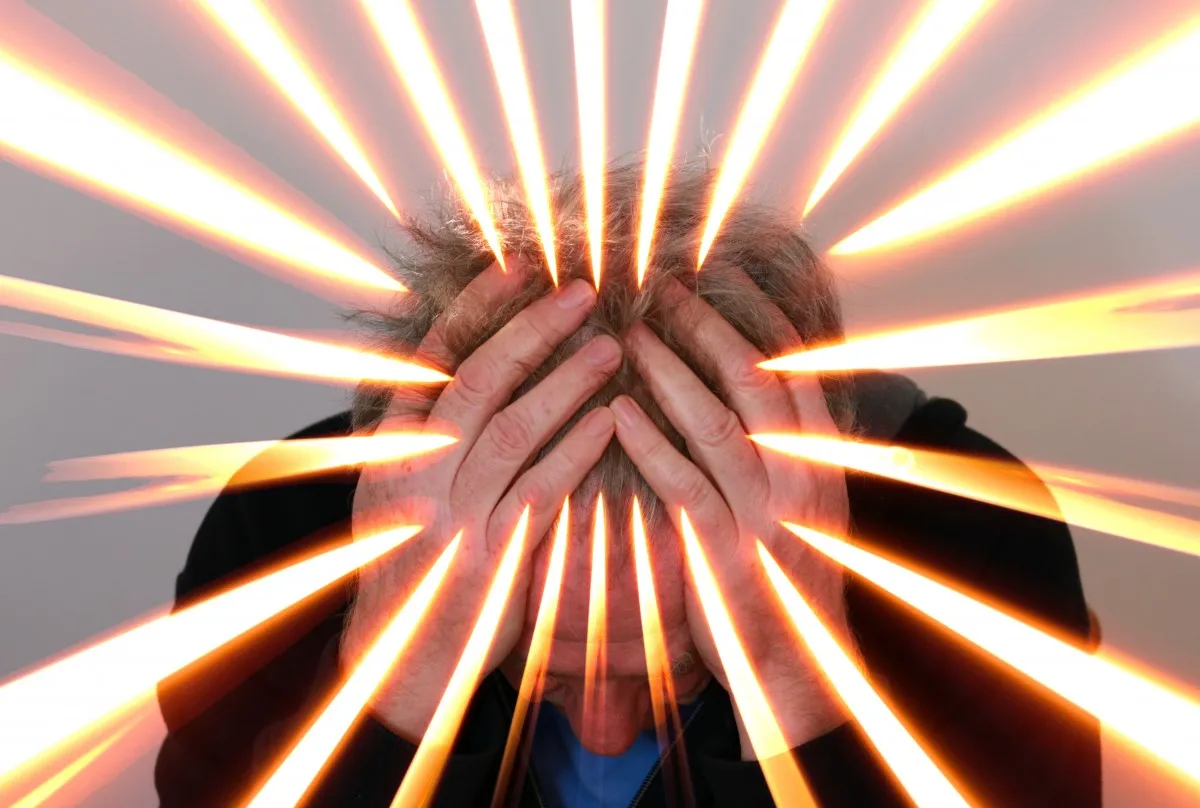Headache - Pain anywhere in the region of the head or neck
 Source
Source
Cause of headache
The brain itself is not sensitive to pain, because it lacks pain receptors. However, several areas of the head and neck do have pain receptors and can thus sense pain. These include the extracranial arteries, middle meningeal artery, large veins, venous sinuses, cranial and spinal nerves, head and neck muscles, the meninges, parts of the brainstem, eyes, ears etc
Headaches are classi cally divided into
Headaches are broadly classified as "primary" or "secondary"
Primary headaches are benign, recurrent headaches not caused by underlying disease or structural problems. For example, migraine is a type of primary headache. While primary headaches may cause significant daily pain and disability, they are not dangerous.
Secondary headaches are caused by an underlying disease, like an infection, head injury, vascular disorders, brain bleed or tumors..
Primary headache syndromes (migraine, tension hwadache, cluster headache)
Secondary causes, which can range from benign (sinusitis) to emergent (subarachnoid hemorrhage [SAH], meningitis, tumor with increased intracranial pressure [ICP]).
** Brain tissue is insensate**.
In benign headache syndromes, pain originates from blood vessels, venoussinuses, the dura, cranial nerves, or extracranial sources (muscle tension).
In emergent headaches, pain may arise from mass effect (tumor or subdural hematoma), inflammation of the meninges (meningitis and SAH), vascular inflammation (temporal arteritis), vascular dissection (carotid and vertebral artery dissection) , or extracranial sources (dental caries, otitis media, sinusitis ).
Emergent Secondary Headaches
Subarachnoid Hemorrhag
Pain is often maximal at onset, in the occipital region, and may resolve spontaneously. The median age at presentation is 50 years. Rupture of an aneurysm is the most common cause.
Meningitis
Classic triad of headache, fever, and meningismus is often not present. It is more difficult to diagnose at extremes of age. Immunosuppression can cause atypical subacute presentations.
Intracranial Bleed
Subdural bleed can occur with minimal or unrecognized trauma (warfarin use, elderly) .
Epidural bleed usually occurs with significant trauma.
Intracerebral bleed is often associated with severe hypertension.
Temporal Arteritis
Occurs in patients older than 50 years and is more frequent in women. It is caused by a systemic panarteritis. Patients present with frontotemporal throbbing headache, jaw claudication, and a nonpulsatile or tender temporal artery. It may cause visual loss from ischemic optic neuritis.
Carotid And Vertebral Artery Dissection
Together these entities cause 20% of strokes in patients younger than 45 years. Carotid dissections occur twice as often as vertebral dissections. Classically, they present as acute unilateral headache and/or neck pain, but may present atypically (lower cranial nerve deficits or C5/6 radiculopathy) . Sometimes dissection occurs in association with minor trauma (yawning) or may be spontaneous.
Pseudotumor Cerebri
Benign intracranial hypertension of unclear cause. It has been linked to the use of oral contraceptives, vitamin A, tetracyclines, and thyroid disorders.
Often occurs in young, obese females with chronic headaches. Papilledema is usually the only abnormal examination finding, but cranial nerve abnormalities, visual field deficits, or decreased visual acuity may also be present.
Stroke
Although 55% of patients with an intracerebral hemorrhage have a headache, less than 17% of ischemic stroke patients complain of pain. However, cerebellar infarction often presents as acute pain in the occipital area. Because of its location in the posterior fossa, there is risk of herniation as surrounding brain edema occurs.
Other
Pituitary apoplexy, acute angle-closure glaucoma, hypertensive encephalopathy, pheochromocytoma, CO poison ing, preeclampsia, venous sinus thrombosis (often in the setting of a hypercoagulable state).
� Primary Headaches
Migraine
Abnormal vascular actlvtty is thought to be causal. Migraines are more common in females, with onset usually in teen years, and less commonly after age 40 years. The patient presents with unilateral pulsating headache that may have an associated aura. The pain usu ally follows a typical pattern for individual patients and improves during pregnancy (estrogen excess). Associated symptoms include nausea and vomiting with photophobia and phonophobia.
Tension Type Headache Source
Source
The most common type of primary headache. Often presents with bitemporal nonpulsating pain without associated nausea, vomiting, photophobia, or phonophobia.
Cluster Headache
Uncommon in the general population, but more common in men beginning after age 20 years. They present with acute, severe, unilateral retro-orbital pain with associated lacrimation, eye injection, and rhinorrhea and usually occur in "clusters" over days to weeks and resolve spontaneously.
Hemicrania continua: severe continuous unilateral episodic pain.
Exertional headache. it is a throbbing, pulsatile pain which starts during or after exercising, lasting for 5 minutes to 24 hours. It is possibly due to straining causing veins in the head to dilate, causing pain.
Honeymoon headache
it is a dull, bilateral headache that starts during sexual activity and becomes much worse during orgasm. These headaches are thought to be due to lower pressure in the head during sex.
Hypnic headache
Moderate-severe headache that starts a few hours after falling asleep and lasts 15–30 minutes. The headache may recur several times during night.
[Text Source](Emergency Medicine by Langah]
[Harrison's Manhal of Intenal Medicine]

